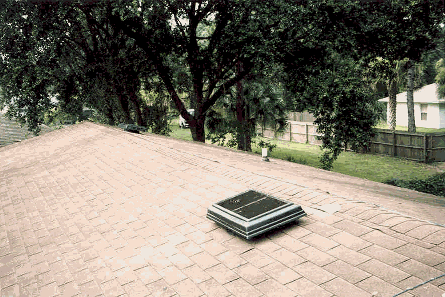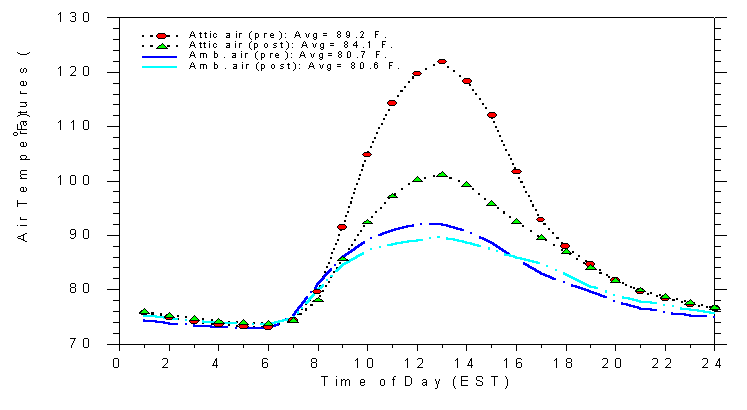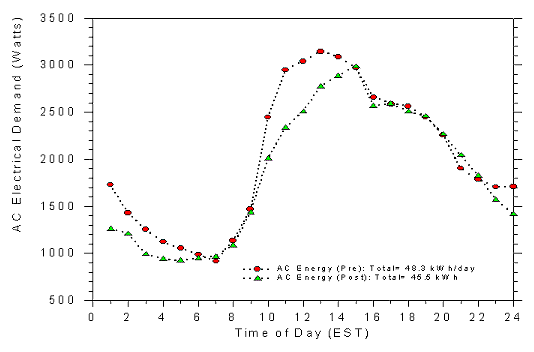
Reference Publication: Danny S. Parker, John R. Sherwin, "Performance Assessment of Photovoltaic Attic Ventilator Fans", Presented at: The Symposium on Improving Building Systems in Hot and Humid Climates, May 15-17, 2000, San Antonio, TX Disclaimer: The views and opinions expressed in this article are solely those of the authors and are not intended to represent the views and opinions of the Florida Solar Energy Center. |
Performance Assessment of Photovoltaic Attic Ventilator Fans
Danny
S. Parker, John R. Sherwin
Florida
Solar Energy Center (FSEC)
FSEC-GP-171-00
Abstract
Controlling summer attic heat gain is important to reducing air conditioning energy use in homes in hot-humid climates. Both heat transfer through ceilings and to attic duct systems can make up a large part of peak cooling demand. Attic ventilation has long been identified as a method to abate such heat gains. We present test results from using the photovoltaic (PV) attic ventilator fans in a test home to assess impact on attic and cooling energy performance.
Background
Improving attic thermal performance is of fundamental to controlling residential cooling loads in hot climates. Accumulating research data have shown that the influence of attics on space cooling demand is not only due to the change in ceiling heat flux when cooling, but very often due to the conditions within the attic itself and their influence on heat gain to duct systems and on air infiltration into the building. The importance of ceiling heat flux has long been recognized with insulation a very effective method of controlling excessive gain. However, when ducts are present in the attic, the magnitude of heat gain to the thermal distribution system under peak conditions can be often much greater than the ceiling heat flux in well-insulated attics (Parker et al., 1993; Hageman and Modera, 1996). (1) This influence may be exacerbated by location of the air handler within the attic space - a common practice in much of the southern U.S. The air handler is both poorly insulated with the greatest temperature difference (the evaporator) of any location of the cooling system. It also has the greatest negative pressures so that some leakage into the unit is inevitable. Evidence for this influence is contained in a monitoring study of sub-metered air conditioning energy in 48 Central Florida homes conducted by Cummings (1991) which found that homes with the air handlers located in the attic used 30% more space cooling energy than those with the air handlers located in garages or elsewhere.
Another emerging phenomenon from buildings research in cooling dominated climates shows that duct system supply air leakage can lead to negative pressures within the house interior when the air handler is operating. This, in turn, can result in hot air from the attic being drawn down to the conditioned space through interior wall headers, recessed cans or other bypasses from the attic to the interior. This phenomenon is commonly encountered in slab on grade homes in the Sunbelt states in the U.S. where the dominant leakage plane to the exterior is through the ceiling.
The Florida Solar Energy Center (FSEC) has performed numerous experiments in test buildings over the last decade on the potential of a variety of methods to reduce attic air temperatures in Florida residences. This includes radiant barrier systems (Fairey et al., 1988), white reflective roofs (Parker et al., 1995), enhanced attic ventilation and roof tiles (Beal and Chandra, 1995). Attic air temperatures vary considerably depending on roofing type, color and ventilation.
Potential Ventilation Impact on Cooling
Forced attic ventilation is a commonly encouraged technique to reduce residential heat gains from the ceiling. However, even those who are in favor of increased attic ventilation have often warned that the energy consumption associated with the attic fan motor is likely greater than any realized energy savings from its use (Wolfert and Hinrichs, 1974). Also, an early detailed study showed that while forced attic ventilation did reduce cooling energy use, the reduction was quite small and outweighed by the energy consumption of the fan itself (Dutt and Harrje, 1979). Another study in two instrumented side-by-side homes in Texas came to similar conclusions (Burch and Treado, 1979). Forced ventilation was found to reduce ceiling heat gain by 1.1 Btu/hr/ft2 (328 W) over soffit venting and gains to the attic duct system by 94 W.(2) At a normal air conditioning COP of 2.5, the overall reduction in cooling energy use could be expected to be approximately 170 W against the measured consumption of 284 W by the ventilation fan. Measured reduction to the maximum cooling load was only 6% for R-11 ceiling insulation. Thus, the powered ventilation does not typically result in a net energy savings for powered vent fans unless the attic is uninsulated. Under this scenario, other means of controlling attic heat gain are preferable and more cost effective than forced ventilation. Other analysis, tends to verify this conclusion. Detailed simulations suggest that the heat transfer in an attic to a residential building interior in mid-summer is dominated by radiative gains from the hot roof decking directly to the insulation surface (Parker et al., 1991; Wilkes, 1991). This mode of heat transfer is more effectively limited by 1) increased attic insulation, 2) a truss-mounted radiant barrier or 3) a white reflective roof surface that limits solar gain to the attic structure.
Although
attic ventilation has been shown to reduce attic air temperatures
and cooling loads the only examination of powered attic ventilators
has shown the electricity consumption of the ventilator fans to be
greater than the savings in air conditioning energy (Burch et al.,
1979). In recent years, however, photovoltaic ventilator fans have
become available which have no parasitic consumption of line electricity.
These tend to be expensive, but are easier to install since no wiring
is required.
Site Description
The test site is a three bedroom single family home located in Cocoa, Florida with approximately 1,045 square feet of conditioned floor space. The household consists of four members with the home occupied most of the day. The home is cooled by a 2.5 ton split system central air conditioner with electric strip heat. The air handler is located in a conditioned utility room. The interior temperature is maintained at a fairly constant 73oF throughout the summer.
The design is a simple rectangular floor plan with the long axis facing east and west (Figure 1). The ceiling of the home has approximately R-19 blown fiberglass insulation. Walls are of frame construction with R-11 insulation. The floor is over an open crawlspace with no insulation. Single pane windows with aluminum frames comprise approximately 12% of the conditioned floor area.

Figure 1. Photo of test site from the east.
The A-frame roof has a 3/12 pitch with asphalt shingles over plywood decking. The dark brown asphalt shingles with an approximate solar absorptance of 92%. A flex duct system is also present in the attic space which distributes the cooled air and is likely influenced by attic thermal conditions. The home had only perforated soffits prior to the retrofit; there were no ridge vents in place.
Instrumentation
A multi-channel data logger recorded various parameters in the home which affect energy use. Type-T thermocouples record the ambient, interior air temperature and attic air temperatures in the home. A pulse initiating power transducer recorded the air conditioner power consumption. A number of other parameters are also recorded at the site including the attic air temperature, the interior temperature and relative humidity. A meteorological station mounted off and above the north edge of the roof records shielded ambient air temperature, humidity, horizontal solar irradiance and wind speed. All data are recorded very 15 minutes and sent back nightly to the host mainframe computer.
Photovoltaic Attic Ventilators
Two PV attic ventilators were installed on the house's asphalt shingle roof on August 6th, 1997.(3) Both were installed near the peak of the A-frame roof with one on the east face and another on the west face as shown in Figure 2. The fans are designed to provided between 600 and 800 cfm of attic ventilation at peak solar irradiance (1000 W/m2) depending on the free soffit ventilation area. The ventilators consist of a 19.5" x 16" mounting with a 10 Watt thin-film PV module. A five bladed radial fan and a direct coupled DC motor provides attic air exhaust. The units were purchased for $300 each; installation would typically add another $100 - $150 per unit.

Figure 2. Photo of PV ventilators.
The home already had a radiant barrier (foil stapled to the roof trusses) with soffit ventilation, but no ridge or other venting. Even with the radiant barrier, however, attic air temperatures of up to 136oF had been measured during the summer leading up to the retrofit.
Analysis
To analyze the impact of the attic ventilators, we looked for several weeks of similar weather in the period before and after the retrofit. Figure 3 shows the measured thermal performance during two matching weather periods. The pre-retrofit period was from July 1st - August 5th; the post period was from August 7th - September 15th. The periods were chosen for their match on average ambient air temperature and solar insolation conditions.

Figure 3. Measured average attic air and ambient air temperatures
over the test period before and after retrofit.
The first plot shows a comparison of the ambient air temperatures (blue) before and after the change. The Upper two lines show the difference in the measure attic air temperature before and after the added ventilation. The daily peak attic air temperature is dropped by an average of 22oF. The monitored attic air temperature over the length of the summer clearly shows the impact of the added attic ventilation as shown in Figure 4.

Figure 4. Monitored attic air temperatures over the summer
test period.
Air conditioner energy use was also measured over the two periods. The AC consumption was reduced by an average of 6.0% (2.8 kWh/day) by the addition of the ventilators, with the largest difference around mid-day. Afternoon savings were not in evidence although differences were noted in evening hours are likely due to the impact of a greater amount of passive ventilation by having the two free outlet areas new the ridge vent area. The measured space cooling reduction load profile is shown in Figure 5.

Figure 5. Measured space cooling demand over the summer
test period.
Space cooling electricity use was sub-metered at the home for the entire year prior to the retrofit, totaling some 7,730 kWh (not including air handler and electric resistance consumption for space heating). Based on the matching period analysis, estimation of annual space cooling savings are on the order of 460 kWh. These savings have a value of approximately $37 at current Florida energy prices. Given that the costs for the two units was approximately $600, or about $850 installed, the payback of the ventilators is not very favorable at over twenty years. It is important to note that this level of savings comes from a home with a radiant barrier system - savings may be larger for cases without a radiant barriers, in homes with less ceiling insulation or those with the air handler unit located in the attic. On the other hand, the monitored test home used more AC energy than the average Central Florida household and this would tend to overstate savings.(4) One impact had nothing to do with energy: the homeowner noted that interior comfort seemed improved after the retrofit even with no adjustment to the thermostat. This may be due to a change in the interior mean radiant temperature.
Other Influences
Recently, the issue of attic ventilation has become a contentious issue, in part due to the lack of scientific basis for the 1:300 free ventilation rate (Rose, 1995), and measured and simulated influences of ventilation on humidity of attic materials in hot humid climates (Burch et al., 1996; TenoWold and Rose, 1999). The major problem is that passively ventilated attic bring in large amounts of moisture laden air into the attics during evening hours when relative humidity is often high. One intrinsic advantage of the PV ventilation scheme is that the attic is well ventilated only during daytime hours only when considerable insolation is present. Coincidently, these also tend to be periods when the ambient relative humidity is low.
We have already described how PV ventilator fans have no parasitic electricity consumption beyond what is generated by the unit. Most attic ventilators often draw 250 - 300 Watts of electric power when in operation (they are typically triggered on when the attic air temperature reaches 105oF or more). This level of electrical use (approximately 10% of the peak air conditioner power draw) is greater than the savings in space cooling energy (Burch et al., 1979). One other advantage of the PV ventilators over AC powered units is noise. Although not quantified within our study, we did note that PV vent fans were almost silent in operation compared with the very noticeable fan noise generated by conventional units.
Conclusions
A case study of photovoltaic attic ventilator fans was conducted on an occupied single family home in Central Florida. Two fans were installed at mid-summer in an instrumented home where attic air temperature, meteorological conditions and space cooling electric power were measured. The home already had an attic radiant barrier, but still experienced attic air temperatures in excess of 130oF.
Comparing periods with similar weather conditions, the test revealed that the PV vent fans have the potential to reduce measured peak summer attic air temperatures by over 20oF. However, the impact over the cooling season is fairly modest with well insulated attics. Measured space cooling reduction was approximately 6% - worth about 460 kWh annually at the test home.
References
Beal, D. and Chandra, S., 1995. "The Measured Per-formance of Tile Roof Systems and Attic Ventilation Strategies in Hot and Humid Climates," Thermal Performance of the Exterior Envelopes of Buildings VI, ASHRAE/DOE/BTECC, p. 753, December, 1995.
Burch, D.M. and Treado, S.J., 1979. "Ventilating Residences and their Attics for Energy Conservation-- An Experimental Study," in Summer Attic and Whole House Ventilation, National Bureau of Standards Special Publication 548, Washington D.C.
Dutt, G.S. and Harrje, D.T., 1979. "Forced Ventilation for Cooling Attics in Summer," in Summer Attic and Whole House Ventilation, National Bureau of Standards Special Publication 548, Washington D.C.
Gu, L., Cummings, J.C., Swami, M.V., Fairey, P.W. and Awwad, S., 1996. Comparison of Duct System Computer Models That Could Provide Input to the Thermal Distribution System Standard Method of Test (SPC-152P), FSEC-CR-929-96, ASHRAE Project 852-RP, Florida Solar Energy Center, Cocoa, FL.
Hageman, R. and Modera, M.P., 1996. "Energy Savings and HVAC Capacity Implications of a Low-Emissivity Interior Surface for Roof Sheathing," Proceedings of the 1996 ACEEE Summer Study on Energy Efficiency in Buildings, Vol. 1, p. 117, American Council for an Energy Efficient Economy, Washington D.C.
Jump, D.A., Walker, I.S. and Modera, M.P., 1996. "Measurements of Efficiency and Duct Retrofit Effectiveness in Residential Forced Air Distribution Systems," Proceedings of the ACEEE 1996 Summer Study on Energy Efficiency in Buildings, Vol. 1, p. 147, American Council for an Energy Efficient Economy, Washington D.C.
Parker, D.S., Fairey, P.F., Gu, L., 1991. "A Stratified Air Model for Simulation of Attic Thermal Performance," Insulation Materials: Testing and Applications, ASTM STP 1116, American Society of Testing and Materials, Philadelphia, PA.
Parker, D.S., Fairey, P.W. and Gu, L., 1991. "A Stratified Air Model for Simulation of Attic Thermal Performance," Insulation Materials: Testing and Applications, ASTM 1116, American Society of Testing and Materials, Philadelphia, PA.
Parker, D.S., Fairey, P.W. and Gu, L., 1993. "Simula-tion of the Effects of Duct Leakage and Heat Transfer on Residential Space Cooling Energy Use," Energy and Buildings 20, p. 97-113, Elsevier Sequoia, Netherlands.
Parker, D.S. and Barkaszi, Jr., S.F., 1997. "Roof Solar Reflectance and Cooling Energy Use: Field Research Results from Florida," Energy and Buildings 14, forthcoming, Elsevier Sequoia, Netherlands.
Rose, W.B., "The History of Attic Ventilation Regulation and Research," Thermal Performance of the Exterior Envelopes of Buildings VI, ASHRAE/DOE/BTECC, p. 125, December, 1995.
Schaeffer, J. 1994. Alternative Energy Sourcebook, 8th Ed., Real Goods Trading Co., Ukiah, CA.
TenoWolde, A. and Rose, W.B., "Issues Related to Venting of Attics and Cathedral Ceilings," ASHRAE Transactions, CH-99-11-4, p. 851-857, Summer, 1999, American Society of Heating, Refrigerating and Air Conditioning Engineers, Atlanta, GA.
Wilkes, K.E., 1991. Thermal Model of Attic Systems with Radiant Barriers, ORNL/CON-262, Oak Ridge National Laboratories, Oak Ridge, TN.
Wolfert,
C.K. and Hinrichs, H.S., 1974. Fundamentals of Residential Attic
Ventilation, H.C. Products Company, Princeville, IL.
1. A simple calculation illustrates this fact. Assume a 2,000 square foot ceiling with R-30 attic insulation. Supply ducts in most residences often comprise a combined area of ~25% of the gross floor area (see Gu et al. 1997, Appendix G, and Jump and Modera 1994), but are only insulated to between R-4to R-6. With the peak attic temperature at 130oF, and 78o maintained inside, a UA dT calculation shows a ceiling heat gain of 3,500 Btu/hr. With R-5 ducts in the attic and a 57o air conditioner supply temperature, the heat gain to the duct system is 7,300 Btu/hr if the cooling system ran the full hour under design conditions -- more than twice the ceiling flux.
2. Interestingly, Burch and Treado (1979) found ridge or turbine ventilation to be nearly as effective as forced ventilation in reducing the overall attic temperature profile, producing an average reduction in the ceiling heat flux of about 19%. Still, however, the authors concluded that this represented no more than a 3% reduction in the overall building cooling load not counting interactions with the duct system.
3. The photovoltaic attic ventilator fans used for the test were model SDF-10, manufactured by Solar Dynamic, Inc. in Ottumwa, Iowa.
4. Note that the air conditioning use at the test home was considerably greater than the average in Florida due to the low cooling thermostat setting. The average annual air conditioning energy use in Central Florida is on the order of 5,500 kWh in existing homes.
